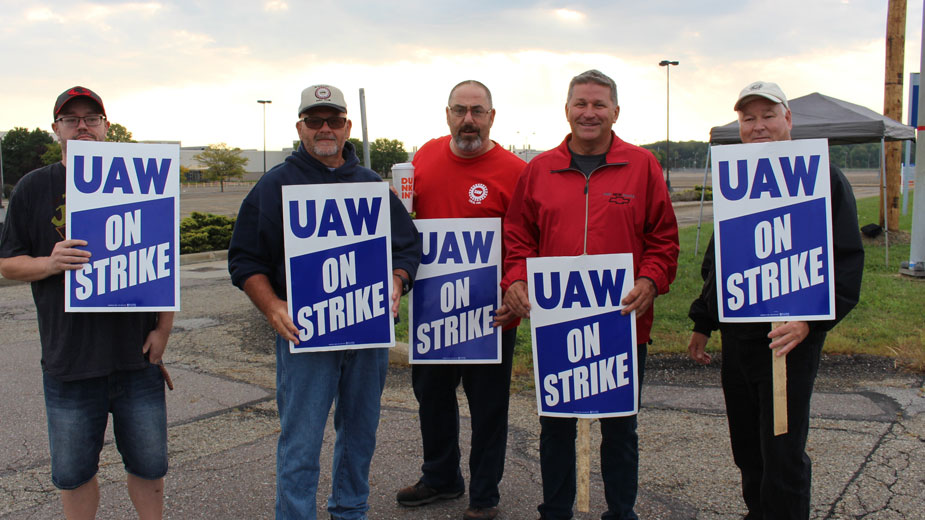As UAW Strike Continues, Lordstown’s Future Still in the Air
YOUNGSTOWN, Ohio — If you asked James Dignan this time last year, he likely wouldn’t have expected the United Auto Workers to strike against General Motors.
But as negotiations seemed to make little to no progress over the summer, the president and CEO of the Youngstown/Warren Regional Chamber said the likelihood of a strike increased. In fact, many of the UAW Local 1112 membership said that by late spring, they were already afraid that it might go in that direction, Dignan said.
“They kind of knew it was coming,” he said.
At midnight Monday, some 49,000 UAW members went on strike at 33 manufacturing plants in nine states and 22 parts distribution warehouses after the existing four-year agreement between the UAW and GM expired – its first national strike since 2007. Negotiations between GM and UAW resumed Monday morning
When Dignan spoke with GM leadership in Detroit seven weeks ago, they stated the company was “still committed to the negotiations and seeing what can happen moving forward,” he said. And while the Lordstown plant “was not a make or break in these negotiations, the future of Lordstown is heavily dependant on these negotiations,” he said, citing recent reports of GM establishing a battery cell manufacturing operation there, “which was the first we heard of any investment promise from GM.”
To encourage such opportunities, the chamber has continued working with GM, as well as state and federal elected officials to “keep up the pressure” to keep investment opportunities coming to Youngstown, he said.
Federal and state elected officials offered their support to the striking workers in person or through the media. U.S. Rep. Tim Ryan, D-13 Ohio, went to the idled GM Lordstown plant to join union members there.
In a statement, Ryan said he “unequivocally” stands in solidarity with the UAW, adding they deserve fair wages, affordable health care and a secure job.
“They’ve dedicated their entire lives to manufacturing award-winning cars and have always stood by GM, transforming it into the company that it is today. It’s time for the car company to do the same,” Ryan said in the statement. “Ten years ago, American taxpayers bailed GM out, but all we’ve gotten in return are factory shutdowns, jobs move overseas, and workers forced to leave their families and communities to find new jobs.
“Not only should GM invest in American workers,” he continued, “they should also invest in American manufacturing. They can start by reopening the plants they closed down this year, including the one in Lordstown, and put Northeast Ohioans back to work.”
U.S. Sen. Sherrod Brown, D-Ohio, echoed that sentiment, urging GM and UAW to work toward a bargaining agreement “that honors the dignity of work,” according to a statement.
“All workers have the right to stand up for fair wages, better working conditions, and increased investments for plants in their local communities, including communities like Lordstown who have been hurt by GM’s recent restructuring,” Brown said in the statement. “Autoworkers stood up and made sacrifices to help save GM when times were tough. All they are asking for is their fair share now that times are good.”
U.S. Sen Rob Portman, R-Ohio, took to Twitter, saying he hopes that agreement is realized soon, with part of it being to keep GM at Lordstown. While some media coverage seems to indicate that GM is “softening its hard stance on Lordstown … I will continue to fight to keep the plant open,” Portman tweeted.
“Lordstown is an award-winning, world-class facility that has been great for GM. The workers and that community deserve to [have] the opportunity to show what they can do with a new product,” Portman tweeted.
Without an agreement, however, GM is free to do what it will with the Lordstown plant, Dignan said. Under the previous agreement, anything GM wanted to do to the plant – including selling it, shutting it down completely or employing a change of investment or vehicle – would have been negotiated with and approved by the UAW, Dignan explained.
Until another agreement is established, GM is under no such obligation.
“If their plan is to partner with someone or give it away or whatever they’re going to do other than its current use, that’s completely up to the corporate entities to make that decision,” Dignan said. “We’re kind of left on the sidelines watching.”
Reaching an agreement is “in everyone’s best interest,” he said. “It costs GM a tremendous amount to stick this out,” and inventory is finite.
Estimates by Credit Suisse shows GM looks to lose some $50 million in earnings daily as long as the strike drags on. Bloomberg reports that the company has more than 820,000 vehicles in its inventory.
Existing inventory should last GM about 100 days between what’s currently on dealers’ lots and what the company has yet to send dealers, said Jon Gabrielsen, an industry analyst. And because dealers are overstocked, “I believe it would barely scratch GM if the strike lasted a month,” he said.
“They have so much stored away that they built ahead of time,” said Gabrielsen, president and CEO of J.T. Gabrielsen Consulting. “I think they could go a month and it wouldn’t even touch their financials.”
Even if the company loses revenue, customers loyal to the brand will wait for a month to get a vehicle they want that might not be on a dealer’s lot, he said, allowing GM to make up what it lost. Ultimately, public perception of the brand is the biggest threat facing GM with the strike, he said.
Since November 2018, GM had taken fire after its announcement to not allocate products to its Lordstown, Detroit-Hamtramck and Oshawa plants. People who work for a living, even if they know nothing of the circumstances, would likely have sympathy for the UAW membership if the strike goes on for a long time, Gabrielsen said.
“It’s unlikely that GM is going to have a better reputation from the strike,” he said. “I think they’re trying to just not make it worse.”
In an effort to “avoid being seen as the bad guy,” GM released details of its offer to the UAW, “and that has never been done before,” he said.
On Sunday, GM said it made an offer that includes more than $7 billion in U.S. investments, creates more than 5,400 jobs, increases pay and improves benefits.
“We presented a strong offer that improves wages, benefits and grows U.S. jobs in substantive ways and it is disappointing that the UAW leadership has chosen to strike at midnight tonight,” the company stated. “We have negotiated in good faith and with a sense of urgency. Our goal remains to build a strong future for our employees and our business.”
In the statement, GM said it offered “solutions for unallocated assembly plants in Michigan and Ohio, investments in eight facilities in four states, introduction of all-new electric trucks, opportunity to become the first union-represented battery cell manufacturing site in the U.S. and additional new vehicle and propulsion programs.”
In addition, the company said it would offer wage or lump sum increased in all four years, improved profit sharing, a ratification payment of $8,000, would retain nationally leading health-care benefits and provide new coverage for autism therapy care, chiropractic care and allergy testing.
That offer, however, came just two hours before the previous contract was set to expire Friday night.
“We are disappointed that the company waited until just two hours before the contract expired to make what we regard as its first serious offer,” said UAW’s Terry Dittes, vice president of the union’s GM division, in a letter to union members. “Had we received this proposal earlier in the process, it may have been possible to reach a tentative agreement and avoid a strike.”
Copyright 2024 The Business Journal, Youngstown, Ohio.



